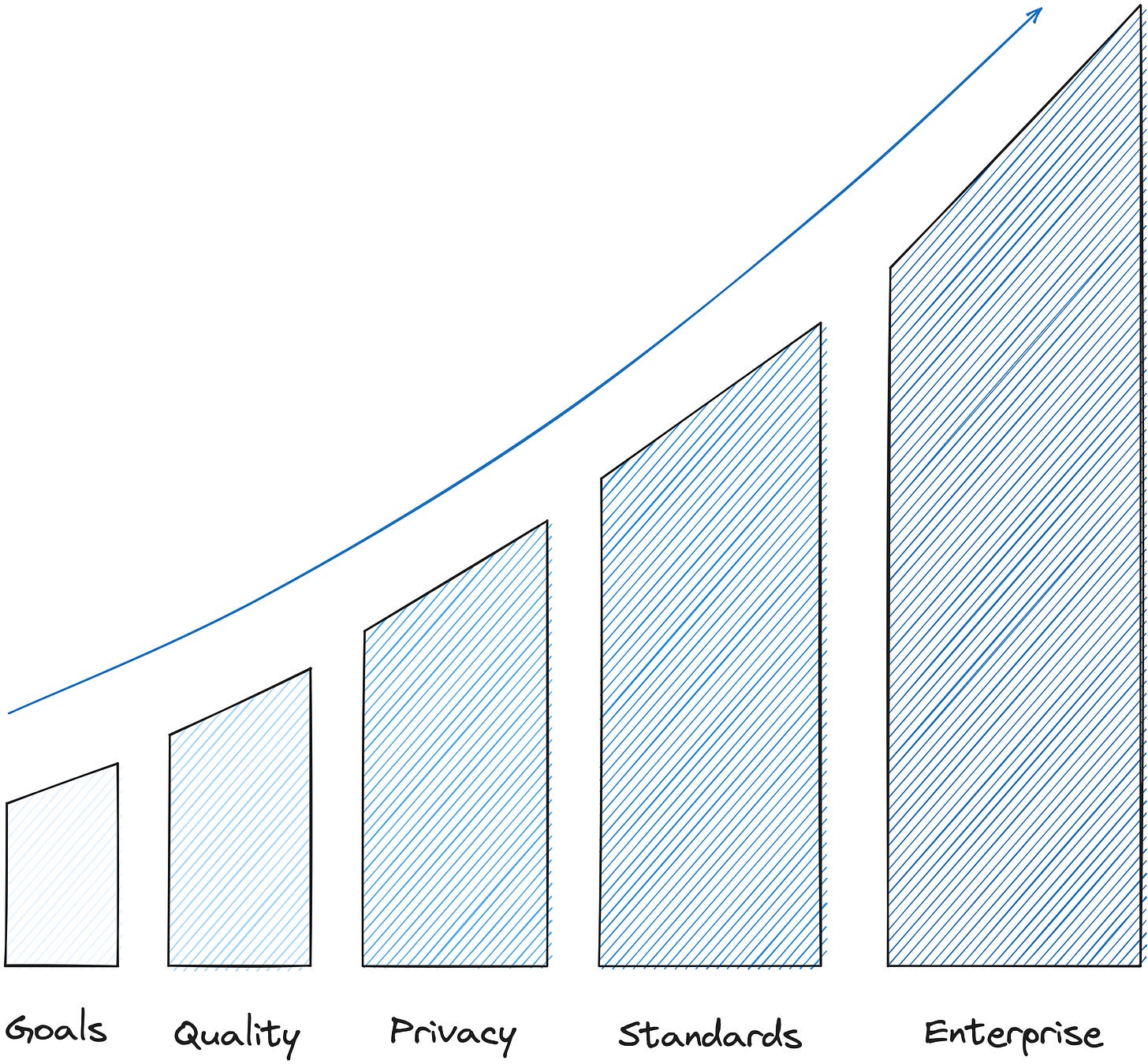Best Practices to Optimize Generative AI Implementation | Issue #28
AI Applications as Consumers, Data as a Product for Fuel
Generative AI, as well as other AI applications, with their remarkable capabilities, have become a driving force across various industries. From streamlining operations to powering creative solutions, its applications are limitless. The sheer volume of data tools available may seem overwhelming, but they bring unprecedented opportunities. However, innovation remains at the core of technological growth, and organizations must adapt to evolving demands and changing landscapes.
In this article, we'll explore how to optimize your AI experience through effective organizational practices and the integration of Product Thinking in data. Let's delve into the key strategies to harness the full potential of generative AI.
Understanding and Solving the Crux: Garbage In, Garbage Out 🗑️
This principle applies to GenAI models just as much as it does to any other type of machine learning model. If you feed your model poor quality data, it will learn the wrong patterns and generate poor quality outputs, no matter how many optimizations you use or state-of-the-art models you deploy.
That's why it's important to use high-quality data to train your AI. This means organising the data, ensuring quality and governance, cleaning, debugging, and formatting it in a way that is compatible with the AI model.
💡 AI, in most fundamental terms, is an equation. In other words, it’s just a channel to process your data and deduce information from it.
🛠️ Organizational Practices to Empower Gen AI: Fix the Input, Optimise the Data
Selecting the Right Tools or Platform
Navigating the sea of data tools can be daunting. The key is to choose tools aligned with your unique needs or data platforms that help you navigate and unify tools and processes. Avoid a one-size-fits-all approach and ensure your chosen technology is tailored to your specific requirements.Continuous Adaptation
Technology and people evolve in tandem. Embrace the idea of constant improvement and adaptability, which is especially frequent in the data space. It's essential to cater to new demands, feature requests, and services, allowing you to stay ahead in the competitive landscape. Adopting evolutionary architectures allows teams and orgs to cushion themselves against these rampant disruptions.Data Optimization
Ensure that your data is of high quality and is well governed. Often data travels across several touchpoints before reaching the end consumer and consequently degrades after each stage. Adopt a self-serve infra for your data that declaratively takes care of the end-to-end data ecosystem, and additionally provides high visibility for root cause analysis and, in turn, continuous optimisation.Reducing Dependencies
Collaboration becomes more seamless when you minimize reliance on centralised data teams and encourage domain self-sufficiency. Empower your organization by developing domain-centred data products and expertise and give back control to businesses by enforcing domain ownership or shifting accountability to the left.Product Thinking in Data
Transition from viewing data as a resource to treating it as a product. Understanding the "why," "how," and "what" of data is the first step in harnessing the potential of data products. This approach streamlines the utilization of generative AI applications and ensures a better user experience.
Data as a product principle is designed to address the data quality and age-old data silos problem; or as Gartner calls it dark data - “the information assets organizations collect, process and store during regular business activities, but generally fail to use for other purposes”. Analytical data provided by the domains must be treated as a product, and the consumers of that data should be treated as customers - happy and delighted customers.
~ Data Mesh Principles
Related Post ➡️
💡 Importance of Product Thinking for Generative AI
Why spend time understanding Data Products? Data is at the forefront of any data-related challenge, and understanding the context is paramount. Applications that depend on data, be it simple machine learning models or complex GenAI apps, are essentially fancy layers which feed on the data underneath.
AI layers are Consumers, and your Data is the Product.
For the same reason, many enterprises experience poor ROI from their AI counterparts due to a consistent denial of poor data they own. Here's why a product approach for data makes sense:
Data as a Product: A Data Product approach shifts the focus to understanding the core of your data challenges. It prompts you to ask the crucial "why" questions before diving into problem-solving. Understanding your data exposes all the opportunities that are feasible for your organisation; before spending hefty time, effort, and cost behind upper layers.
Better User Experience: Treating data as a product enhances the user experience, as your approach becomes more tailored to the needs of your organization. Hyper personalisation is activated and operationalised at the data level even before data enters the application layers.
Reducing Dependencies: Collaboration and innovation flourish when the reliance on and resistance from external and centralised data teams diminish. Data Products empower domain experts who understand the business and are therefore able to strategies the right applications for various customer segments.

Related Post ➡️
🔄 Using Data Products to Reduce Loopholes
Define Clear Goals: Proactively establish key performance indicators, end goals, and use cases to maximize the effectiveness of generative AI.
Harnessing Standards: Generative AI's performance relies on high-quality data. Ensure that your data collection and preparation processes meet the highest standards.
Prioritize Privacy: In the age of data ethics and privacy concerns, it's essential to own the data used for AI training and consider the implications of data usage on privacy.
Quality Matters: The quality of your data directly impacts the outcomes of generative AI technology. Source and use high-quality data for the best results.
Enterprise Adoption: For enterprise-scale generative AI, invest in skilled data analysts, engineers, and machine learning experts. Create a Center of Excellence to ensure a steady flow of feedback and streamline training and maintenance of custom models.
⚡️ Organizational Strategies to Boost Efficiency
Verification and Testing: Implement rigorous verification and testing strategies to ensure the accuracy and reliability of generative AI results.
Example: If you use Wikipedia content to train your generative AI model, it is important to be aware of the potential for bias and misinformation. Wikipedia is a valuable resource, but it is also editable by anyone, which means that the information it contains may not always be accurate or reliable.
Design for Responsibility: Early identification of potential harms, responsible datasets, and robust discussions with external experts are essential for building trustworthy AI.
Integration with Data Analytics: Choose data analytics tools that seamlessly integrate with generative AI models to streamline data analytics operations.
Start Small: Don't attempt to solve all data analytics problems at once with generative AI. Start with small pilot projects to understand their potential.
Active Engagement: Involve everyone in your organization in the process of integrating generative AI and consider establishing a Center of Excellence dedicated to AI integration.
By following these best practices, your organization can optimize the use and implementation of generative AI, stay ahead in technology, and unlock innovative possibilities in a rapidly evolving landscape.
Follow for more on LinkedIn and Twitter to get the latest updates on what's buzzing in the modern data space.
Feel free to reach out to us to become a contributor or reply with your feedback/queries regarding modern data landscapes. We look forward to your much-valued input.







